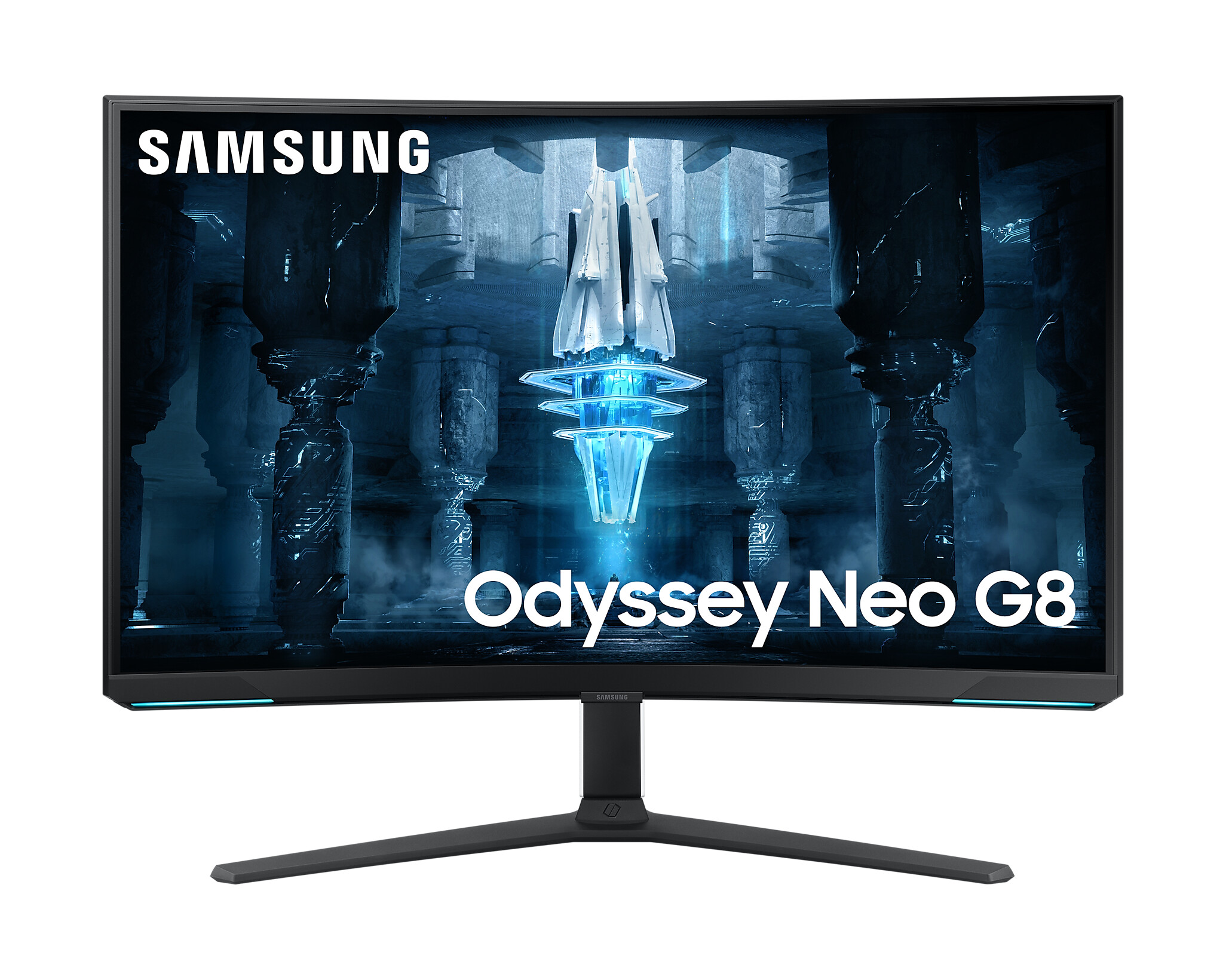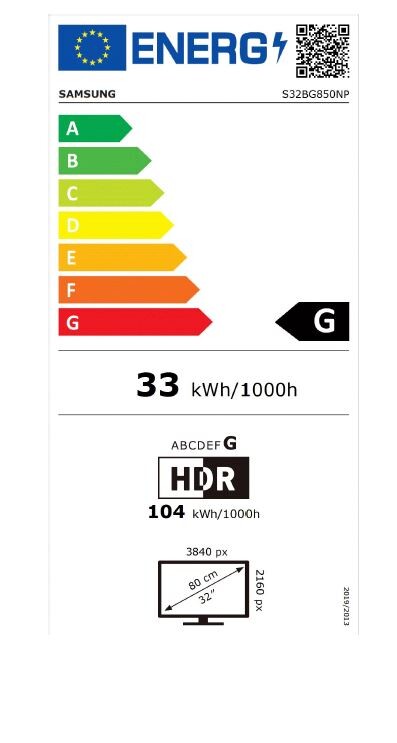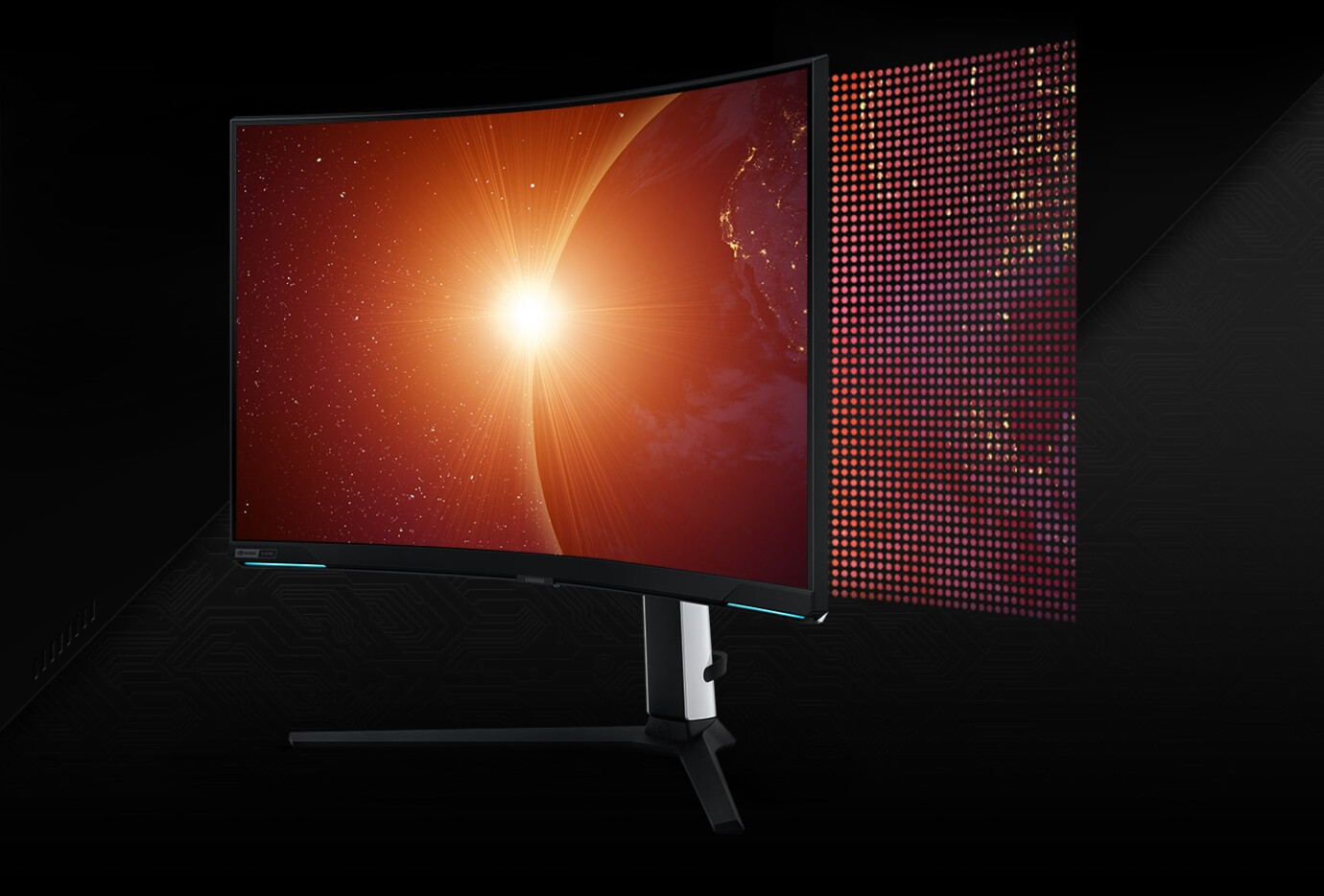



































£700.99*
- Resolution 3840 x 2160 4K UHD
- Diagonal 32"
- Panel type VA
- Refresh Rate 240Hz



Product information
Odyssey Gaming Monitor Neo G8 (32")
- Quantum Matrix Mini-LED
- 240 Hz refresh rate
- 1.000R Curved Panel
- High colour fidelity with 95% DCI-P3 colour space coverage
- Eye Saver Mode
- Flicker Free
- FreeSync Premium Pro
- Quantum HDR 2000
Submerge yourself in your content
Quantum Matrix Technology
An unmatched visual experience. Revolutionary Quantum Matrix technology with Quantum Mini LEDs produces controlled brightness and perfect contrast for refined resolution. Local dimming zones have been increased to 1,196 and combined with the highest 12-bit black levels to deliver picture quality that is second to none.

Discover every detail
Quantum HDR 2.000
Discover every detail in all its glory. From dim shadows to brilliant skies, 2,000 nit peak brightness and a 1,000,000:1 contrast ratio enable enhanced colour representation and depth. Give yourself an advantage when playing ray traced games by spotting well-hidden enemies by their reflections.

A gaming equipment of the extra class
UHD resolution & 240Hz refresh rate
Let your opponents look old: With an outrageously fast 240Hz refresh rate, the Neo G8 was awarded Best of Innovation at CES 2022. It pushes the boundaries of what monitors can do, delivering blazing speeds, immersion and depth to realise the full potential of gaming.
Stay tuned
FreeSync Premium Pro
AMD FreeSync Premium Pro keeps the GPU and panel in sync to eliminate judder, screen lag and image tearing. Fast action as well as complex game scenes are thus stable and smooth so you can react quickly.

Dive into your game
1,000R Curved Screen
Let the atmosphere envelop you and experience a thrillingly realistic gaming experience. The Neo G8's 32-inch display fills your peripheral field of vision and lets you take in your character's view.

Designed to light up your world
Integrated lighting with CoreSync
Engage with impressive lighting in every scene. Core lighting lets you add a personal touch to your setup with multiple colour modes that pop off the screen and into your reality. Get immersed in your gaming world with CoreSync technology that matches the screen to the colours of your game.

Less distraction from ambient light
Matte display
Focus on what matters: The matte display absorbs artificial and natural light instead of reflecting it. So even in the toughest battles and most difficult levels, you can stay fully focused on what's happening.

Air hidden details in your games
Ultrawide Game view
Keep your eye on the prize. Set your screen to 21:9 to discover hidden areas in game scenes with Ultrawide Game View. Now when you play football games, you can see more of the pitch. And in racing games, you get a natural and comprehensive view of the road ahead.

Plug in and get started
Automatic Source Switch Plus
Directly into the game: You don't have to reconnect your cables in a complicated way. With Automatic Source Switch Plus, your monitor can recognise newly connected devices the first time they are plugged in. So you no longer have to search for the right input source.

All in view
Ergonomic design
Look forward to high flexibility for even more comfort: Your monitor can be tilted, swivelled and adjusted in height so that you have a perfect view of your opponents. Connectors are easily accessible, so you can plug in your favourite devices without creating a mess.
Technical data
| Name | Samsung Odyssey Neo G8 S32BG850NP 32" VA Monitor, 3840 x 2160 4K UHD, 240Hz, 1ms |
|---|---|
| Article number | 1000027625 |
| GTIN/EAN | 8806094796582 |
| Manufacturer SKU | LS32BG850NPXEN |
| EPREL ID | 1401629 |
| Model name | S32BG850NP |
| Brand | Samsung |
| Product Type | Monitor |
| Product Series | Samsung Odyssey Series |
| Technology | LCD |
| Panel type | VA |
| Resolution | 3840 x 2160 4K UHD |
| Diagonal | 32" |
| Aspect Ratio | 16:9 |
| Viewing angle - Horizontal | 178° |
| Viewing angle - Vertical | 178° |
| Contrast Ratio | 1,000,000 :1 |
| Max. Brightness | 350 cd/m² |
| Response time | 1ms |
| Refresh Rate | 240Hz |
| Support - VESA | 100 x 100 |
| Inputs | 1x Displayport , 2x HDMI , 3x USB-A |
| Features | AMD FreeSync , Flicker Free |
| Product width | 71.3 cm |
| Product height | 43.48 cm |
| Product depth | 17.3 cm |
| Weight | 7 kg |
| Colour | White |
| EEK Spectrum | A to G |
| Energy efficency class | G |
| Delivery contents | DisplayPort Cable , Power cable |
| Condition | New |
| Warranty | 36 Month |
| Warranty type | Bringin service Service and support information |
Downloads
Product safety
| Person responsible for the EU |
|---|
| Samsung Electronics GmbH |
| Am Kronberger Hang 6 |
| 65824 Schwalbach |
| Germany |
| sseg.comm@samsung.com |



